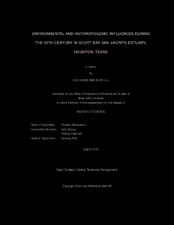| dc.description.abstract | In the past century the San Jacinto Estuary (SJE), including the Houston Ship Channel (HSC) and its surrounding area, has experienced a significant increase in industrialization and urbanization. As a result of industrialization, sediments accumulating in the bay are contaminated with pollutants. In the past century, this area has also experienced up to 3 m of land subsidence due to anthropogenic groundwater removal for growing urbanization.
Other influences on the watershed and bay are storm associated floods, like that of Hurricane Harvey which hit the Texas coast on August 25, 2017 causing record rain fall in the Houston and Harris County areas resulting in severe flooding. A storm of this magnitude has the possibility to significantly disturb the sediment column to release any previously buried pollutants and to flood the nearby EPA Superfund sites, adding to the toxins in the water column with the potential for further impact to the area.
In two parts, this study reconstructed the history of an environmental change from riverine to estuarine dominated system in the San Jacinto Estuary by the identification of benthic foraminifera ecology shift, and historic storm events through sediment age dating by Pb210 through several sediment cores taken pre-Hurricane Harvey. The pre-Harvey core analysis indicated a few clear signals correlating to historical Hurricane storm events and but no clear signals correlating to the building of the San Jacinto Dam. A closer look at the contaminants found in the pre-Harvey cores indicated an increased abundance of “stressed” benthic foraminifera individuals correlating with the prominent Hg peaks identified in core SB1. Then using the benthic foraminifera record, there was a significant change in the environment indicated by a change from no saline/brackish, therefore riverine environment, specific species below 100cm, down core, to the estuarine environment species, like that of Ammonia beccari, becoming the dominant species in the Scott Bay and lower SJE region.
Then in the second part, Hurricane Harvey influenced the estuary system by causing massive amounts of freshwater to flood the environment causing erosion and a redistribution of previously buried contaminants. The pre-Harvey core samples indicated Hg concentrations being higher than that of the Post-Harvey Hg concentrations due to the flux of freshwater from the floods eroding the river beds, as well as the benthic foraminifera record showing that the flux of freshwater from SJR and Buffalo Bayou flooding caused a decrease in saline specific species abundance closer to the HSC bed.
This study proved evident how highly influenced the lower San Jacinto Estuary system is influenced, not only by the anthropogenic activities near by, but the significant storm events that come through the area. | en |


